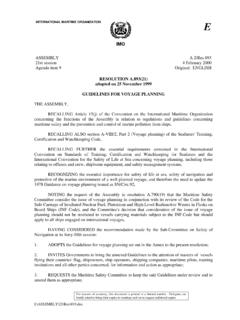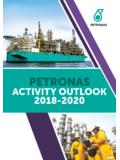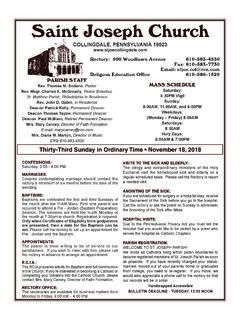Transcription of Pacific Pilotage Authority Pilotage Waiver …
1 Revised september 15, 2017 . Pacific Pilotage Authority Pilotage Waiver Standard of Care . Implementation Guidelines Introduction PPA waivers are granted subject to the Pilotage Act, Pacific Pilotage Regulations and these Implementation Guidelines. The first two are legislative and regulatory instruments that set the minimum conditions under which vessels are required to engage Pilotage services through PPA. These also provide PPA the flexibility to issue waivers from this requirement to ships engaged in regular trade through these waters. The provision of the Waiver must be made with reasonable confidence that an acceptable Standard of Care is being maintained by the waivered company, vessel and crew, such that the risk to life, property and the environment is not substantially greater than would be anticipated if the vessel were under a pilot's direction.
2 Therefore, these Standard of Care requirements, while not having the force of law, comprise the conditions under which PPA consents to grant waivers to qualified applicants. Nothing in this document or the Pacific Pilotage Regulations shall be construed as having an effect contrary to the Canada Shipping Act, 2001 and Regulations established thereunder for the safe operation of shipping in accordance with Canada's compliance with IMO Conventions. Similarly, these guidelines should not be considered to relieve or in any way limit the master's Authority and responsibility to navigate his vessel in accordance with the prevailing conditions, applicable regulations, limitations of the vessel, and the good practice of seamen.
3 These guidelines are arranged under key headings for ease of reference. Tonnage All vessels over 350 GT (International Tonnage Convention measure) are required by the Pacific Pilotage Regulations to carry pilots in the compulsory Pilotage areas of the BC coast. This tonnage threshold applies to the combined tonnage of composite vessels, whether tug and tow, multiple strings of barges, or Integrated/Articulated Tug-Barge (ITB/ATB). units. Waivers are available to all vessels under 10,000 GT, upon application to PPA and having satisfied the conditions as laid out below. Yachts under 500 GT are exempt under the Pacific Pilotage Regulations. Pacific Pilotage Authority - Pilotage Waiver Standard of Care Page 1.
4 Revised september 15, 2017 . Certification/Manning All vessels applying for waivers must be manned in accordance with the Marine Personnel Regulations. Masters and mates must be appropriately certified for the vessel type and tonnage. US vessels transiting Canadian waters under waivers must be manned in accordance with Art V of the 2002 MOU between USCG/TC regarding Mutual Recognition of Domestic Mariner Qualifications. Yachts over 500 GT but under 10,000 GT must be manned by Canadian or United States of America officers to obtain a Waiver . Zones For the purpose of waivers, the following six zones are established: 1. Fraser River, below the New Westminster bridge;. 2. Fraser River, above the New Westminster bridge.
5 3. Second Narrows (MRA-2);. 4. Salish Sea (Race Rocks to Seymour Narrows);. 5. Seymour Narrows to Pine Island, and West Coast Vancouver Island west of Race Rocks;. 6. Central & North Coast (Pine Is to Dixon including Haida Gwaii). Note: these zones are distinct from the five Pilotage Areas defined in PPA Regulations. Individual Navigational Experience When applying for a Waiver as a master or watchkeeping officer, individuals must provide documentary evidence of the following experience: a. 150 days at sea in coastal waters within the last 18 months, or 365 days at sea (which are understood as 12-hr days of watchkeeping duty) in coastal waters within the last 60 months, which time may be accumulated in a position as any member of the deck watch of a ship over 25 GT (single vessel or combined tonnage of tug & tow), AND.
6 B. Documented trips associated with the zones for which the Waiver is being sought, which time may be accumulated as any member of the deck watch under the supervision of a qualified Waiver holder or pilot, as follows by zone: 1. 5 round trips;. 2. 10 round trips;. 3. 6 round trips;. 4. 10 transits (each equivalent to at least 2 x 12-hr days of watchkeeping experience) within the zone;. 5. 10 transits (each equivalent to at least 2 x 12-hr days of watchkeeping experience) within the zone;. 6. 10 transits (each equivalent to at least 2 x 12-hr days of watchkeeping experience) within the zone. Pacific Pilotage Authority - Pilotage Waiver Standard of Care Page 2. Revised september 15, 2017 .
7 Companies or Waiver applicants may propose to PPA a combined programme of experience, training, simulation or examination equivalent to the above requirements. Vessels When vessels are operating under Waiver , the following Standard of Care is required: a. All vessels operating under a Waiver must be fitted with and operating a Bridge Navigational Watch Alarms System (BNWAS)1 set to (at most) 10- minute intervals; and b. All vessels operating under a Waiver shall be fitted with and transmitting on Class A AIS. The AIS system must be in compliance with SOLAS V. These requirements shall not apply to 12-hour shift boats (day boats) operating with two persons constantly present. Watchkeeping in Confined Waters (see Annex 1 attached re Marine Personnel Regulations).
8 Confined waters is defined as any passage in which the vessel's planned track necessitates passing within 1 nautical mile of grounding dangers to the vessel. The requirements of the Marine Personnel Regulations must be complied with at all times, however when the vessel is operating in confined waters of the Inside Passage or West Coast of Vancouver Island, the following rules are emphasized when considering a waivered vessel: a. Two persons must be on the bridge for all confined waters, b. Two persons must be on the bridge in conditions of restricted visibility; and c. The master must be on the bridge for transits of First Narrows, Second Narrows, Fraser River (only Sand Heads to Steveston Island, and passing New Westminster Railway Bridge), Seymour Narrows, Blackney and Weynton Passages, Broughton Pass, Lama Pass, Boat Bluff or Heikish Narrows, Princess Royal Channel, Grenville Channel, and Principe Channel.
9 Conditions (a) and (c) do not apply to vessels operating solely within the established limits of a port, or to vessels towing logs. Condition (a) is considered to have been met if two persons are on watch and the second person leaves the bridge for other duties for periods no longer than 10 minutes at a time. This may be extended beyond 10 minutes if the ship is fitted with a BNWAS, 1. The Bridge Navigational Watch Alarm system (BWNAS) must be in compliance with SOLAS and Resolution (75) Performance standards for a bridge navigational watch alarm system (BNWAS) . Pacific Pilotage Authority - Pilotage Waiver Standard of Care Page 3. Revised september 15, 2017 . as long as the second person establishes regular contact with the bridge by voice.
10 Note: This relaxation of the requirement for two persons on the bridge should only be considered available in conditions of daylight and good visibility. Marine Personnel Regulations Sections 207 and 213-216 require that the deck watch of vessels up to 500. GT consist of at least two persons. The IMO Principles to be Observed in Keeping a Navigational Watch (STCW 2010 Section A-VIII/2 Part 4-1) infer that the additional person's function is that of lookout (without distraction of other duties) but allows that the officer in charge of the watch may be the sole lookout in daylight under favourable conditions. Transport Canada makes this interpretation explicit in Ship Safety Bulletin of 2017 .






